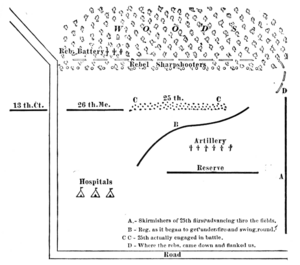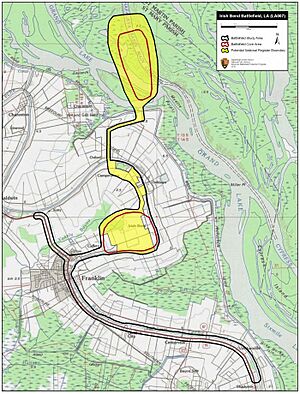Battle of Irish Bend facts for kids
Quick facts for kids Battle of Irish Bend |
|||||||
|---|---|---|---|---|---|---|---|
| Part of the American Civil War | |||||||
 Sketch of the battle for Harper’s Weekly |
|||||||
|
|||||||
| Belligerents | |||||||
| Commanders and leaders | |||||||
| Nathaniel P. Banks Cuvier Grover |
Richard Taylor | ||||||
| Units involved | |||||||
| XIX Corps | Army of Western Louisiana | ||||||
| Casualties and losses | |||||||
| 353 | unknown | ||||||
The Battle of Irish Bend, also known as Nerson's Woods or Franklin, was a fight during the American Civil War. It happened on April 14, 1863, in St. Mary Parish, Louisiana.
This battle was part of a larger plan by Union (Northern) forces to control the Bayou Teche area. Union Major General Nathaniel P. Banks led his troops against Confederate (Southern) Major General Richard Taylor. The Union won this battle.
Contents
About the Battle of Irish Bend
Why the Battle Happened
The Union Army wanted to control western Louisiana. They planned an expedition into the area. Two divisions of Union soldiers, led by Major General Nathaniel P. Banks, were moving towards Fort Bisland.
At the same time, another Union group, led by Brigadier General Cuvier Grover, went up the Atchafalaya River. Their goal was to reach Grand Lake. From there, they could either stop the Confederates from escaping or force them to leave Fort Bisland. The Battle of Irish Bend happened just two days after the Battle of Fort Bisland.
The Fight Begins
On the morning of April 13, 1863, General Grover's soldiers landed near Franklin, Louisiana. They quickly pushed back Confederate troops who tried to stop them. That night, Grover ordered his division to cross Bayou Teche. They got ready to attack Franklin at dawn.
However, Confederate Major General Richard Taylor knew his army was in danger. He started moving his soldiers away from Fort Bisland. His first troops arrived quickly near Franklin.
The Main Clash
On the morning of April 14, Taylor and his men were at Nerson's Woods. This was about a mile and a half (2.4 km) from Franklin. As Grover's lead group marched forward, they found Taylor's soldiers. Small fights, called skirmishes, began.
The fighting became very intense. The Confederates attacked hard, making the Union soldiers fall back. A Confederate gunboat named Diana helped protect the Confederate right side along the Teche.
Union Victory
Even with the strong Confederate defense, General Grover's men had more soldiers. When Grover paused to get all his troops ready, Taylor decided to pull back. He did not want to risk a big battle against a larger force.
Grover's men successfully took the important position they wanted. This victory, along with the one at Fort Bisland two days earlier, helped the Union succeed in their mission in western Louisiana.
Who Fought in the Battle
Union Forces
The Union forces were part of the Army of the Gulf, led by Major General Nathaniel P. Banks.
- 4th Division – Led by Brigadier General Cuvier Grover
- 1st Brigade – Led by Brigadier General William Dwight
- 2nd Brigade – Led by Colonel William K. Kimball
- 3rd Brigade – Led by Colonel Henry Birge
- Reserve Artillery – Led by Colonel James W. McMillan
Confederate Forces
The Confederate forces were part of the District of West Louisiana, led by Major General Richard Taylor.
- Mouton's Brigade – Led by Brigadier General Jean Jacques Alfred Alexander Mouton
- Sibley's Brigade – Led by Brigadier General Henry Hopkins Sibley
- Unattached – 2nd Louisiana Cavalry Regiment – Led by Colonel William G. Vincent
See also
 In Spanish: Batalla de Irish Bend para niños
In Spanish: Batalla de Irish Bend para niños



